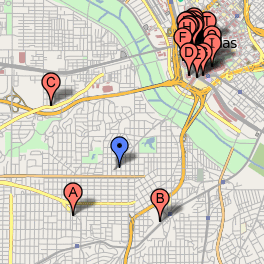After some months (it could be argued, years), Rocco Landsman, Chair of the National Endowment for the Arts (NEA) has put together a national organization dedicated to building creative places in cities around the country, demonstrating the vital link between the arts and economic development.
Called ArtPlace, it continues the work of the NEA to fund a li grants, ranging from $25,000 to $250,000, for "creative placemaking." These projects, the NEA believes, "contribute toward the livability of communities and help transform them into lively, beautiful, and sustainable places with the arts at their core."
Landsman, among others in the Obama administration, philanthropies and corporations alike, have argued that creative places or "creative clusters" as they are also called, are the incubators of creativity and crucial to development of a creative and innovative workforce.
But the ArtPlace idea is big, certainly bigger than anything ever done before ... and has the potential to be a "game changer." If, and it's still an if in many cities, ArtPlace not only gets artists and art and cultural organizations, and community leaders to think differently about renewing their downtowns, but acts as the catalyst America so badly needs to awaken to the challenges of working, playing and living in a new economy -- a creative and innovative economy.
The NEA has already invested $6.5 million in projects in over 51 communities, called Our Town, which:
•Improve quality of life.
•Encourage creative activity.
•Create community identity and a sense of place.
•Revitalize local economies.

Now together with the Ford Foundation, whose President is serving as Chairman of the ArtPlace Council, Bloomberg Philanthropies , the James Irvine, John S. and James L.Knight , Kresge , McKnight, Andrew W. Mellon , Rockefeller, Rasmuson, Robina, and an anonymous donor, ArtPlace has already listed winners of 34 communities winning over $11 million, and working to identify other projects to leverage $12 million more to spur the development of similar efforts.
But can $12 million -- even $ 12 million a year -- make the difference? Maybe.
ArtPlace plans to work with the federal government " to ensure that grants align with high-priority federal investments and policy development." This includes the NEA, of course, and the departments of Housing and Urban Development, Health and Human Services, Agriculture, Education and Transportation, along with leadership from the White House Office of Management and Budget and the Domestic Policy Council. As partners, these departments participate in operating committee meetings, and are an integral part of ArtPlace management. The net net of such collaboration could be huge, and a major step toward redesigning the land use and architecture of communities across America for the "Creative and Innovative Age."
"Creative Placemaking" as defined by the NEA are places where "arts, culture and creative industries come together to make communities a great place to live work and play." Ann Markusen, one of leading experts in this field and author of "Creative Placemaking," makes it clear in a white paper prepared along with Anne Gadwa of Metris Consulting for the Mayors' Institute on City Design, that "creative placemaking's livability and economic development outcomes have the potential to radically change the future of American towns and cities...(designed to) foster entrepreneurs and creative industries that generate jobs and income."
The new effort appears to take the broader definition in the sense that all industries -- not just the so-called creative industries (which include film, television, graphic design, publishing, etc.) -- must be creative and innovative to succeed and survive in the new economy.
Toward that end, ArtPlace says it is more likely to invest in proposals which "integrate with a community's economic development and community revitalization strategy, have the potential to attract additional private and public support to the community", and will likely result in a new "vibrancy" i.e., "attracting people, activities and value to a place and increasing the desire and the economic opportunity to thrive in a place".
ArtPlace will be headed by Carol Colletta formerly head of CEOs for Cities, host and producer of a syndicated public radio show called Smart City, and executive director of the Mayors' Institute on City Design, a partnership of the National Endowment for the Arts, the United States Conference of Mayors and the American Architectural Foundation. While Carol is starting with a lean staff-her-more will be added as needed. Carol Colletta is a seasoned pro and as such expresses only cautious optimism. "This is a three-year demonstration," she says "(but) if successful, is expected to have a long life."
Organizations, and individual who wish to apply for a grant from ArtPlace, should review the guidelines on ArtPlace's website and complete the Letter of Inquiry by November 15, 2011. Applicants can also register for a webinar on October 3 at 3pm ET to learn more about developing a Letter of Inquiry.